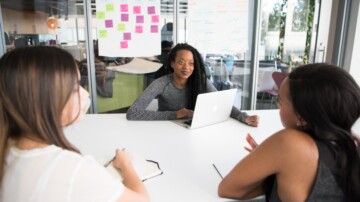It Takes Two to Table

Don’t tell anyone, but there was a time in my life when I didn’t know what “tabling” was. I was familiar with the idea of kitchen tables (for doing homework, eating dinner), coffee tables (for displaying large books and a few stems of an in-season flower), bed side tables (often crowded with books, to-do lists, glasses of water, and hair things)… but it wasn’t until my entrance into the wonderful world of grassroots organizing that I truly learned “how to table.”
Tabling, as defined by an informal survey of several of my favorite organizing buddies, is the act of standing behind or near a table in a conference setting to distribute branded swag, engage with conference attendees, and gather the names and contact information of constituents.
I learned to table from the best of ‘em… other grassroots organizers that is. I learned all the tricks to make a table popular (candy!) and how to keep passers-by flowing at a good rate so nobody actually monopolized the table’s real estate in a crowded conference setting. And above all else, I learned how to rake in the e-mail addresses so I could follow-up with folks post conference. I pressed all these tabling skills into service over the last two weeks when I attended both the Non-Profit Technology Conference in DC and the Association for Fundraising Professionals Conference in Chicago.
Here are a few rules of the road to follow as you pack up that fancy display, mini Snickers, and tons of branded pens and head to conferences in the future.
Capture Contact Information
Sure, it is fun to talk about the fact that your parents live in the same apartment building as the person who just stopped by your table (side note: this really happened), but getting a name and e-mail address can help turn this new best friend into next year’s top donor.
- Consider using an iPad with a form optimized for mobile and encourage conference attendees to share their e-mails that way. Learn more about the way we did this at Convio’s 2010 Summit here.
- …Or invest in some fancy touch screen technology (Convio used a business card scanner) to capture information and share materials, paperlessly, from visitors from your table.
- Don’t forget about the old school method of a clip board and a pen (people are more likely to look at, and eventually sign up on, something you hand to them so don’t keep the clip board flat on the table…).
- If your organization has an advocacy campaign running right now, use the petition language as a sign-up tool as well.
Follow-Up
Once you’ve got the contact info, use it! There’s nothing worse than getting the “thanks for signing up” e-mail months after a conference ends (okay, there are worse things, but this is certainly not a best practice).
- Don’t forget to send a note (or maybe a series of notes) to the people who signed up at your table. This should be done as quickly as possible, before your new housefile members have time to misplace their conference totes and have stopped gabbing about what they learned to their unlucky friends who didn’t make the trip.
- Consider putting the folks who signed up at a specific conference into their own Welcome Series (a set of automated e-mails triggered to send when new housefile members join your list).
- If you go the petition route, provide an update on how the advocacy campaign is doing and additional ways to get involved (such as an upcoming event or national call-in day).
- Share links to the online versions of presentations given at the conference (try using SlideShare for easy sharing of PowerPoint presentations).
- As with all “thanks for signing up” e-mails, include an obvious places make a donation, invite friends to sign up, and links to your social media hot spots.
And with that, tabling rockstars, I think you’re ready to go! Oh, I almost forgot… don’t forget to wear comfortable shoes and stay hydrated while on your tabling shift, too.


